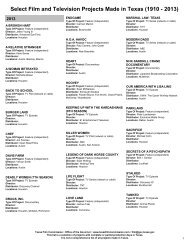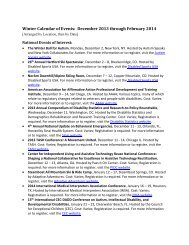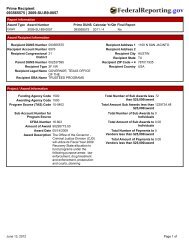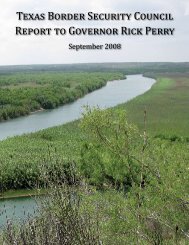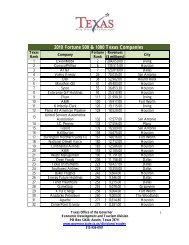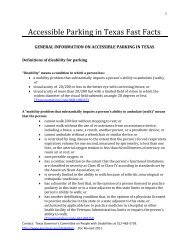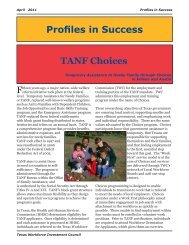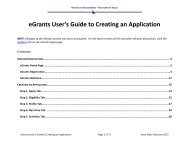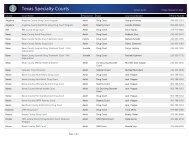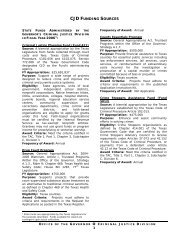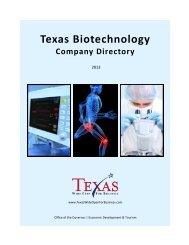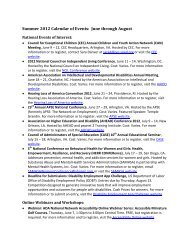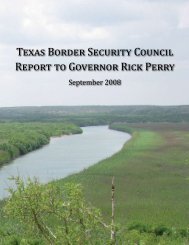Report on GCPD H1N1 Survey Personal Preparedness Planning for ...
Report on GCPD H1N1 Survey Personal Preparedness Planning for ...
Report on GCPD H1N1 Survey Personal Preparedness Planning for ...
Create successful ePaper yourself
Turn your PDF publications into a flip-book with our unique Google optimized e-Paper software.
1 | P a g e<br />
The Texas Governor’s Committee <strong>on</strong> People with Disabilities<br />
<strong>Survey</strong> of Pers<strong>on</strong>al <strong>Preparedness</strong> <strong>Planning</strong> <strong>for</strong> Texans with<br />
Disabilities in a Pandemic Influenza Event<br />
Introducti<strong>on</strong><br />
The Texas Governor’s Committee <strong>on</strong> People with Disabilities is a divisi<strong>on</strong> within the Governor’s Office<br />
that advises <strong>on</strong> a wide range of disability issues related to Texans with disabilities. In existence since<br />
September of 1950, the Texas Governor's Committee <strong>on</strong> Employment <strong>for</strong> the Handicapped was first<br />
created by Governor Dolph Briscoe in 1978 through Executive Order DB-40. Executive orders by<br />
governors William P. Clements in 1981 and 1987 and Mark White in 1983 c<strong>on</strong>tinued the committee, with<br />
Executive Order MW-10 changing the name to the Texas Governor's Committee <strong>for</strong> Disabled Pers<strong>on</strong>s. In<br />
1991 the Texas Governor's Committee <strong>on</strong> People with Disabilities was created statutorily by Senate Bill<br />
381.<br />
The Texas Governor’s Committee <strong>on</strong> People with Disabilities (<strong>GCPD</strong>) works toward a state where people<br />
with disabilities have the opportunity to enjoy full and equal access to lives of independence,<br />
productivity, and self-determinati<strong>on</strong>. The Governor appoints twelve members to serve <strong>on</strong> the Committee,<br />
seven of whom must be people with disabilities. Representatives from six state agencies serve as ex<br />
officio or advisory members. The Committee makes recommendati<strong>on</strong>s to the Governor and Legislature<br />
<strong>on</strong> disability issues; promotes compliance with disability-related laws; promotes a network of local<br />
communities/committees doing similar work; and recognizes employers and media professi<strong>on</strong>als <strong>for</strong><br />
employing and positively depicting Texans with disabilities. The members and staff also provide<br />
technical assistance, in<strong>for</strong>mati<strong>on</strong> and referral services to citizens of Texas <strong>on</strong> issues affecting Texans with<br />
disabilities. The Committee structures its work around ten broad issue areas related to access,<br />
communicati<strong>on</strong>, educati<strong>on</strong>, emergency management, health, housing, recreati<strong>on</strong>, transportati<strong>on</strong>, veterans<br />
and work<strong>for</strong>ce. The Committee’s enabling law is outlined in the Texas Human Resources Code, Chapter<br />
115.<br />
One of the Committee’s functi<strong>on</strong>s is to serve as a central source of in<strong>for</strong>mati<strong>on</strong> and educati<strong>on</strong> <strong>on</strong> the<br />
abilities, rights, problems, and needs of pers<strong>on</strong>s with disabilities and, as necessary, issue reports. As part<br />
of our fulfillment <strong>for</strong> this functi<strong>on</strong>, the Committee issues this report <strong>on</strong> its assistance to Texans with<br />
disabilities during the <strong>H1N1</strong> flu pandemic of 2009.<br />
This is not the first time the world has seen a pandemic event. Over the past three centuries, the world<br />
has seen a flu pandemic every 30 to 40 years. (1) Throughout history, influenza viruses have mutated and<br />
caused pandemics or global epidemics. In 1890, an especially virulent influenza pandemic struck, killing<br />
many Americans. Those individuals who survived the 1890 pandemic and lived to experience the 1918<br />
pandemic tended to be less susceptible to the disease, however, worldwide 50 milli<strong>on</strong> people died from<br />
the world’s most devastating flu pandemic.<br />
Texas first reported the disease as being present in the state <strong>on</strong> September 23rd of 1918. However, the<br />
disease was probably present in the state be<strong>for</strong>e that date. As early as September 12th, newspapers were<br />
reporting that fears of the disease spreading into the state were comm<strong>on</strong>. On September 23rd, state<br />
officials reported the presence of influenza in Williams<strong>on</strong> County, Kaufman County and Bosque County.<br />
By October 4, 1918, thirty-five counties reported influenza; these counties reported anywhere from <strong>on</strong>e to
2 | P a g e<br />
two thousand cases. A week later, the disease was reported present in seventy-seven counties, with the<br />
number of cases varying from <strong>on</strong>e to four thousand cases per county. During the week of the October<br />
18th, the state failed to report; this failure may have been because officials were overwhelmed. On the<br />
October 25th, the state reported a total of 26,062 cases and 517 deaths since the beginning of the<br />
pandemic. By October 29th, the state had reported 106,978 cases and 2,181 deaths in just the state's urban<br />
centers. Because state officials were so overwhelmed and because it was difficult <strong>for</strong> states to collect data,<br />
these numbers were probably inaccurate. The actual number of cases and deaths was probably much<br />
higher.<br />
To get an idea of how high those numbers were in the early 1900’s, the total Texas populati<strong>on</strong> in 1920<br />
was 4.66 milli<strong>on</strong>. San Ant<strong>on</strong>io was the largest city in the state with a populati<strong>on</strong> of 161,379. Dallas had a<br />
populati<strong>on</strong> of 158,976; Houst<strong>on</strong> had a populati<strong>on</strong> of 138,276; Fort Worth had a populati<strong>on</strong> of 106,482 and<br />
El Paso had a populati<strong>on</strong> of 77,560.<br />
Thankfully, in 2009 our healthcare, resources and ability to communicate is infinitely better than it was<br />
back then. In 1918, the Texas State Board of Health made the following suggesti<strong>on</strong>s <strong>on</strong> how to prevent<br />
flu outbreaks in schools:<br />
"Every day ... disinfectant should be scattered over the floor and swept. All woodwork, desks, chairs,<br />
tables and doors should be wiped off with a cloth wet with linseed, kerosene and turpentine. Every pupil<br />
must have at all times a clean handkerchief and it must not be laid <strong>on</strong> top of the desk. Spitting <strong>on</strong> the<br />
floor, sneezing, or coughing, except behind a handkerchief, should be sufficient grounds <strong>for</strong> suspensi<strong>on</strong> of<br />
a pupil. A pupil should not be allowed to sit in a draft. A pupil with wet feet or wet clothing should not be<br />
permitted to stay at school."<br />
The Dallas Morning News maintained that surviving the flu required "medical attenti<strong>on</strong>, good nursing,<br />
fresh air, nutritious food, plenty of water and cheerful surroundings." (2)<br />
Our knowledge of viruses has exp<strong>on</strong>entially improved over time so fast <strong>for</strong>ward to June of 2009.<br />
Background<br />
In June of 2009, staff of the Texas Governor’s Committee <strong>on</strong> People with Disabilities (<strong>GCPD</strong>) was<br />
invited to participate in the N<strong>on</strong>- Pharmaceutical Interventi<strong>on</strong> Workgroup or NPI under the Texas<br />
Department of State Health Services, (DSHS) by John Litaker of the Litaker Group. The Litaker Group<br />
since 2004 has provided specialist services in health and medical preparedness and evaluati<strong>on</strong>, research,<br />
and public policy to governmental agencies and private industry. They were instrumental <strong>on</strong> the post<br />
evaluati<strong>on</strong> and reporting of less<strong>on</strong>s learned from Hurricane’s Rita and Katrina.<br />
The invitati<strong>on</strong> to participate in the NPI coincided with the June 11, 2009 announcement by the World<br />
Health Organizati<strong>on</strong> (WHO) signaling that a global pandemic of the novel influenza A (<strong>H1N1</strong>) was<br />
underway which raised the worldwide pandemic alert level to Phase 6.<br />
The workgroup met bi-weekly until the end of July 2009 to address DSHS internal procedures, develop<br />
guidelines and best practices <strong>for</strong> the 2009 <strong>H1N1</strong> influenza pandemic. Angi English, Executive Director of<br />
the Governor’s Committee and Kathy Matejek, Accessibility and Disability Rights Coordinator<br />
participated as representatives of <strong>GCPD</strong> and provided technical assistance <strong>on</strong> unique issues related to<br />
Texans with disabilities.
3 | P a g e<br />
In additi<strong>on</strong> to bi-weekly meetings, the NPI workgroup used an <strong>on</strong>line project management applicati<strong>on</strong><br />
known as Tracti<strong>on</strong>. Founded in 1996, Tracti<strong>on</strong>® Software, Inc. (<strong>for</strong>merly Twisted Systems, Inc.) set out<br />
to eliminate the frustrating and costly inefficiencies in team communicati<strong>on</strong>s and in<strong>for</strong>mati<strong>on</strong><br />
management by creating a revoluti<strong>on</strong>ary web-based hypertext Journal. This tool has been used by many<br />
agencies including the Central Intelligence Agency (CIA) just after 9/11 as a resp<strong>on</strong>se to the need <strong>for</strong><br />
diverse groups and organizati<strong>on</strong>s over a wide geographic range to communicate with each other<br />
effectively and efficiently. The use of Tracti<strong>on</strong> by the State of Texas represents its first use in disease<br />
communicati<strong>on</strong> in resp<strong>on</strong>se to a pandemic event. Tracti<strong>on</strong> updates are received by email notificati<strong>on</strong><br />
instantly when they are posted. All workgroup participants had access and upload rights to Tracti<strong>on</strong>. The<br />
primary resources <strong>for</strong> materials <strong>on</strong> Tracti<strong>on</strong> are varied but primarily include in<strong>for</strong>mati<strong>on</strong> from medical<br />
journals and scientific organizati<strong>on</strong>s, the CDC and the federal pandemic flu site, flu.gov. Additi<strong>on</strong>ally,<br />
individuals could comment <strong>on</strong> any posting and every<strong>on</strong>e could benefit by the feedback that was provided.<br />
One of the most pressing issues of the time was the need <strong>for</strong> a pers<strong>on</strong>al preparedness plan <strong>for</strong> pandemic<br />
influenza, especially <strong>for</strong> those Texans with disabilities whose health may already be compromised. The<br />
CDC had issued its in<strong>for</strong>mati<strong>on</strong> <strong>on</strong> people most at risk which included a large number of people with<br />
disabilities. Am<strong>on</strong>g people with disabilities, the following groups are at higher risk of acquiring the<br />
<strong>H1N1</strong> infecti<strong>on</strong>:<br />
People who have difficulty breathing – (ventilator users and individuals with asthma and other<br />
respiratory c<strong>on</strong>diti<strong>on</strong>s – this could include individuals with a range of disabilities such as<br />
intellectual and developmental disabilities, cerebral palsy, spinal cord injury, seizure disorders,<br />
and metabolic c<strong>on</strong>diti<strong>on</strong>s).<br />
People who have difficulty fighting infecti<strong>on</strong>s or who are immunocompromised – (individuals<br />
with HIV, cancer, and other types of immune suppressi<strong>on</strong>, or individuals using<br />
immunosuppressive medicati<strong>on</strong>s).<br />
People of any age who have chr<strong>on</strong>ic health c<strong>on</strong>diti<strong>on</strong>s (heart disease, metabolic [i.e., diabetes],<br />
renal, hepatic, hematological [i.e. sickle cell anemia], pulm<strong>on</strong>ary, or neurological disorders).<br />
People who have pharmacological dependency.<br />
People younger than 19 years of age who are receiving l<strong>on</strong>g-term aspirin therapy due to their<br />
risk of developing Reye’s syndrome.<br />
Children pr<strong>on</strong>e to dehydrati<strong>on</strong> from poor nutriti<strong>on</strong>al and fluid intake caused by prol<strong>on</strong>ged<br />
vomiting and diarrhea, or underlying metabolic c<strong>on</strong>diti<strong>on</strong>s.<br />
Disability groups at risk of getting flu and/or having unrecognized flu symptoms include:<br />
People who have limited mobility or who cannot limit coming into c<strong>on</strong>tact with others who are<br />
infected, like staff and family members<br />
People who have trouble understanding or practicing preventive measures such as hand washing<br />
People who may not be able to communicate symptoms of illness<br />
People who may not be m<strong>on</strong>itored closely <strong>for</strong> symptoms of illness (3)<br />
It was early in the summer, but a sec<strong>on</strong>d wave of <strong>H1N1</strong> was expected in the fall. <strong>GCPD</strong> staff began<br />
compiling in<strong>for</strong>mati<strong>on</strong> resources gathered by the workgroup, using Tracti<strong>on</strong>, al<strong>on</strong>g with various <strong>on</strong>line<br />
sources such as the Centers <strong>for</strong> Disease C<strong>on</strong>trol, (CDC), Flu.gov and the World Health Organizati<strong>on</strong><br />
(WHO) to create a technical resource document called, ―Texans Preparing <strong>for</strong> Pandemic Influenza.‖
4 | P a g e<br />
(Appendix B) At the same time, the staff created an accessible <strong>on</strong>line survey with two goals aimed at<br />
assisting Texans with disabilities by providing necessary preparati<strong>on</strong> in<strong>for</strong>mati<strong>on</strong> <strong>for</strong> the pandemic and to<br />
gather data about the state of preparedness of those same citizens.<br />
<strong>Survey</strong> M<strong>on</strong>key was selected <strong>for</strong> its overall accessibility and user friendliness. Additi<strong>on</strong>al benefits of<br />
<strong>Survey</strong> M<strong>on</strong>key included:<br />
Secti<strong>on</strong> 508 compliance<br />
Ease of use, no training necessary and a variety of templates<br />
Unlimited survey questi<strong>on</strong>s and unlimited surveys during the c<strong>on</strong>tract period<br />
The ability to run reports in multiple <strong>for</strong>mats such as PDF, Excel, and HTML<br />
Support of multiple languages, and<br />
Various opti<strong>on</strong>s <strong>for</strong> design reporting and analysis<br />
On August 7, 2009 the <strong>GCPD</strong> staff posted <strong>on</strong> its organizati<strong>on</strong>al website a new page <strong>on</strong> <strong>H1N1</strong> in<strong>for</strong>mati<strong>on</strong>,<br />
which included downloadable documents in English and Spanish, links to local, state and federal<br />
in<strong>for</strong>mati<strong>on</strong> and a link to the survey <strong>Survey</strong> of Pers<strong>on</strong>al <strong>Preparedness</strong> <strong>Planning</strong> <strong>for</strong> Texans with<br />
Disabilities in a Pandemic Influenza Event which was also in English and in Spanish.<br />
Notice of the new in<strong>for</strong>mati<strong>on</strong> <strong>on</strong> the <strong>GCPD</strong> site, including an invitati<strong>on</strong> to take the survey, was broadcast<br />
to <strong>GCPD</strong> Committee members, Committee ex-officio members, the Texas Work<strong>for</strong>ce Commissi<strong>on</strong><br />
Disability Navigators, Local Mayor’s Committee <strong>on</strong> People with Disabilities, The Accessibility Council<br />
of Texas, various listserves including the accessible technology listserve called TechLunch, the ADA<br />
Coordinator’s listserve called, TEXADAC, various disability organizati<strong>on</strong>s, the Accessibility Council of<br />
Texas (ACT), and the Texas Centers <strong>for</strong> Independent Living. C<strong>on</strong>tacts were asked to distribute the<br />
survey widely in their areas. Additi<strong>on</strong>ally, sister state agencies posted <strong>on</strong> their websites:<br />
Texas Governor’s Committee <strong>on</strong> People with Disabilities<br />
Texas Department of State Health Services: TexasFlu.org<br />
Texas A & M University: Project REDD: Research and Educati<strong>on</strong> <strong>on</strong> Disability and Disaster<br />
Invitati<strong>on</strong>s were sent to the members of Nati<strong>on</strong>al Associati<strong>on</strong> of Governor’s Committee’s, NAGC to use<br />
the survey in each of their states by changing the state name. <strong>GCPD</strong> offered to host the surveys and<br />
<strong>for</strong>ward weekly reports to NAGC participants. Only <strong>on</strong>e state, Louisiana and its Governor’s Advisory<br />
Council <strong>on</strong> Disability Affairs participated in the invitati<strong>on</strong>.<br />
Between August 7, 2009 and December 31, 2009, there were resp<strong>on</strong>dents from 113 counties (44.4%).<br />
There were a total of 620 resp<strong>on</strong>dents to the Texas survey, 613 in English and 7 people in Spanish.<br />
<strong>Survey</strong> Results <strong>for</strong> “Pers<strong>on</strong>al <strong>Preparedness</strong> <strong>Planning</strong> <strong>for</strong> Texans with<br />
Disabilities in a Pandemic Influenza Event”<br />
Pers<strong>on</strong>al in<strong>for</strong>mati<strong>on</strong><br />
I am a Texas resident:<br />
o Yes: 601 (97.9%)<br />
o No: 13 (2.1%)<br />
My primary language is:
5 | P a g e<br />
o English: 586 (96.5%)<br />
o Spanish: 14 (1.3%)<br />
o Other: (2.1%)<br />
o Filipino: 1<br />
o American Sign Language: 12<br />
I am:<br />
o A parent, guardian or caregiver who is answering <strong>for</strong> a child 6 m<strong>on</strong>ths to 18 years of age:<br />
120 (19.9%)<br />
o 18 to 24 years of age: 39 (6.5%)<br />
o 25 to 49 years of age: 194 (32.9%)<br />
o 50 to 64 years of age: 204 (34.6%)<br />
o 65 or older: 36 (6.1%)<br />
I am a Texan with <strong>on</strong>e or more of the following (check all that apply):<br />
o I am a Texan who is blind or visually impaired: 64 (10.5%)<br />
o I am a Texan who is deaf or hard of hearing: 63 (10.3%)<br />
o I am a Texan with mobility impairment: 150 (24.8%)<br />
o I am a Texan with a cognitive impairment: 77 (12.7%)<br />
o I am a Texan with a physical impairment: 175 (28.7%)<br />
o I am a Texan with a mental illness: 51 (8.5%)<br />
o I am a Texans with special dietary needs: 67 (11.2%)<br />
o I am a Texan who has a pers<strong>on</strong>al care attendant: 54 (9.0%)<br />
o I am a Texan who depends <strong>on</strong> Meals <strong>on</strong> Wheels or a similar program: 9 (1.5%)<br />
o I am a Texan who depends <strong>on</strong> in home care: 50 (8.0%)<br />
o I am a Texan who depends <strong>on</strong> oxygen: 24 (4.0%)<br />
o I am a Texan who needs dialysis: 1 (.2%)<br />
o I am a Texan who depends <strong>on</strong> a Service Animal: 24 (4.0%)<br />
o I am a Texan who depends <strong>on</strong> the internet to order supplies: 46 (7.7%)<br />
o I do not have a disability but my spouse, child or other family member <strong>for</strong> whom I am<br />
resp<strong>on</strong>sible does have a disability: 133 (22.0%)<br />
o I do not have a disability: 146 (24.2%)<br />
I live:<br />
o In live in an area with more than an hour commute to grocery, pharmacy or medical care:<br />
23 (3.9%)<br />
o I live in an area with less than an hour commute to grocery, pharmacy or medical care:<br />
575 (96.1%)<br />
I live in this Texas County:<br />
Resp<strong>on</strong>dents from 113 or 44.4% of the 254 counties in Texas participated in the survey.<br />
I get my in<strong>for</strong>mati<strong>on</strong> from (check all that apply):<br />
o TV: 530 (87.2%)<br />
o Radio: 332 (54.6%)<br />
o Newspaper: 303 (49.9%)<br />
o Internet: 520 (85.7%)<br />
o Teleph<strong>on</strong>e: 226 (37.1%)<br />
o Text messaging: 131 (21.7%)<br />
o TTY: 2 (0.3%)
6 | P a g e<br />
<strong>Survey</strong><br />
1. I have a pers<strong>on</strong>al preparedness plan <strong>for</strong> pandemic flu:<br />
o Yes: 119 (22.3%)<br />
o No: 419 (77.7%)<br />
2. I have a list of providers with c<strong>on</strong>tact in<strong>for</strong>mati<strong>on</strong> <strong>for</strong> (check all that apply):<br />
o My primary health care provider: 382 (70.5%)<br />
o Other healthcare providers: 156 (28.9%)<br />
o My pharmacy: 317 (58.6%)<br />
o My durable medical equipment supplier: 60 (11.1%)<br />
o My local health department: 66 (12.1%)<br />
o My pers<strong>on</strong>al emergency c<strong>on</strong>tact: 201 (37.1%)<br />
o My local emergency services and police: 154 (28.6%)<br />
o I do not have a list: 144 (26.5%)<br />
3. I have a support network of family and friends that I can c<strong>on</strong>tact or who would c<strong>on</strong>tact me<br />
in a pandemic situati<strong>on</strong>.<br />
o Yes: 444 (82.9%)<br />
o No: 93 (17.1%)<br />
4. I have their c<strong>on</strong>tact in<strong>for</strong>mati<strong>on</strong> posted near the teleph<strong>on</strong>e.<br />
o Yes: 258 (48.5%)<br />
o No: 276 (51.5%)<br />
5. I have discussed with my employer <strong>on</strong>e or more of the following in the event of pandemic flu<br />
(check all that apply):<br />
o Teleworking: 35 (6.6%)<br />
o My opti<strong>on</strong>s <strong>for</strong> staying home to care <strong>for</strong> sick child or family member: 56 (10.5%)<br />
o My opti<strong>on</strong>s <strong>for</strong> staying home with children when schools are closed: 28 (5.1%)<br />
o How business will c<strong>on</strong>tinue during a pandemic: 56 (10.5%)<br />
o Leave policies <strong>for</strong> a pandemic: 46 (8.7%)<br />
o I have not discussed any of these things with my employer: 191 (35.6%)<br />
o This does not apply to me: 240 (44.8%)<br />
6. I have alternate arrangements <strong>for</strong> childcare if schools or daycare are closed:<br />
o Yes: 85 (15.7%)<br />
o No: 69 (13.0%)<br />
o Not applicable: 380 (71.3%)<br />
7. I have discussed with my health care provider and insurance provider the need <strong>for</strong> a twoweek<br />
supply of medicati<strong>on</strong>s:<br />
o Yes: 94 (17.8%)<br />
o No: 325 (60.9%)
7 | P a g e<br />
o I am not taking medicati<strong>on</strong>: 114 (21.4%)<br />
8. I have discussed with my health care provider (check all that apply):<br />
o If and under what circumstances I might need antiviral medicati<strong>on</strong>s: 63 (12.1%)<br />
o When I will qualify to receive a pandemic flu vaccine: 73 (14.0%)<br />
o Where I go to receive the pandemic influenza vaccine: 51 (9.8%)<br />
o When to call my health care provider if I have symptoms: 68 (13.0%)<br />
o Under what circumstances should I seek emergency help <strong>for</strong> flu symptoms: 63 (12.1%)<br />
o I have not discussed any of these things with my health care provider: 380 (72.0%)<br />
9. I rely <strong>on</strong> the following types of transportati<strong>on</strong> (select <strong>on</strong>e or more):<br />
o Para transit: 30 (5.6%)<br />
o Special transit: 36 (6.8%)<br />
o Taxi: 31 (5.4%)<br />
o Ride sharing: 15 (2.8%)<br />
o General bus service: 43 (8.1%)<br />
o Family or friends: 196 (36.2%)<br />
o My pers<strong>on</strong>al vehicle: 397 (73.9%)<br />
o Other: 32 (6.0%)<br />
10. I have a back-up plan <strong>for</strong> transportati<strong>on</strong>:<br />
o Yes: 236 (45%)<br />
o No: 288 (55%)<br />
11. I have a two week supply of the following (check all that apply):<br />
o Ready to eat n<strong>on</strong>-perishable canned or Meals Ready to Eat (MRE) meats, fruits, vegetables,<br />
beans or soups, crackers and canned juices: 193 (36.1%)<br />
o 1 gall<strong>on</strong> of water per family member per day <strong>for</strong> drinking and extra water <strong>for</strong> sanitati<strong>on</strong>: 141<br />
(26.2%<br />
o Over the counter medicati<strong>on</strong>s <strong>for</strong> flu symptoms such as stomach aches, cough and cold<br />
medicines, fluids with electrolytes, and anti-diarrheal medicati<strong>on</strong>s: 189 (35.2%)<br />
o Pers<strong>on</strong>al hygiene items that include anti-bacterial soaps, alcohol based hand sanitizers,<br />
tissues, shampoo, toothpaste and toilet paper: 329 (61.6%)<br />
o Household supplies that include a manual can opener, batteries, flashlight, cleaning supplies<br />
and garbage bags: 332 (62.2%)<br />
o A thermometer: 312 (59.2%)<br />
o List of internet resources <strong>for</strong> possible delivery of goods and services to your home: 61<br />
(11.4%)<br />
o Food and water <strong>for</strong> pets and service animals: 177 (33.1%)<br />
o Medicati<strong>on</strong>s <strong>for</strong> pets and service animals: 61 (11.4%)<br />
o I do not have a two week supply of these things: 162 (29.6%)<br />
12. If you have a pet or service animal, do you have a pet emergency kit or a pet care plan?<br />
o Yes: 47 (9.1%)<br />
o No: 255 (48.4%)<br />
o I do not have a pet or service animal: 220 (42.3%)
8 | P a g e<br />
13. I have easy access to the following important documents (check all that apply).<br />
o My identificati<strong>on</strong>: 497 (92.5%)<br />
o My medical history: 229 (42.5%)<br />
o My Social Security card: 465 (86.5%)<br />
o My insurance cards: 462 (86.2%)<br />
o My medical equipment c<strong>on</strong>tact: 112 (20.7%)<br />
o My call or email list of emergency c<strong>on</strong>tacts: 263 (49.0%)<br />
o I do not have easy access to any of these documents: 20 (3.6%)<br />
14. Which of these did you know are ways to avoid getting the flu (check all that apply)?<br />
o Washing your hands well and often, especially be<strong>for</strong>e eating: 521 (96.8%)<br />
o Using alcohol based hand sanitizers if washing facilities are not available: 478 (89.0%)<br />
o Keeping hands and fingers away from eyes, nose and mouth: 479 (89.3%)<br />
o Sneezing or coughing into your sleeve: 465 (86.7%)<br />
o Getting exercise and plenty of rest: 409 (76.2%)<br />
o Eating a healthy diet: 445 (83.0%)<br />
o Avoiding large crowds: 438 (81.6%)<br />
o Wearing a surgical mask protects me from others who have the flu: 271 (50.2%)<br />
o Wearing a Niosh 95 (N95) mask protects others from me if I have the flu: 136 (25.1%)<br />
o N<strong>on</strong>e of the above: 4 (.7%)<br />
15. Since there is a chance that the seas<strong>on</strong>al flu and <strong>H1N1</strong> flu could occur during the<br />
hurricane seas<strong>on</strong>, I have:<br />
o Back-up power in case of a power failure: 85 (16.1%)<br />
o A battery powered or hand crank radio <strong>for</strong> news: 174 (32.8%)<br />
o A NOAA Weather Radio with t<strong>on</strong>e alert or flash: 93 (17.6%)<br />
o A whistle to signal <strong>for</strong> help: 74 (14.0%)<br />
o A flashlight with extra batteries: 319 (60.0%)<br />
o A family plan <strong>for</strong> communicati<strong>on</strong> and check-ins: 123 (23.1%)<br />
o An evacuati<strong>on</strong> plan from my home: 124 (23.5%)<br />
o N<strong>on</strong>e of the above: 173 (32.4%)
9 | P a g e<br />
Analysis of the <strong>Survey</strong>:<br />
Resp<strong>on</strong>dents to the survey were predominately Texas residents (97.9%) who were English speaking<br />
(96.5%) with the other languages being Spanish (1.3%) or American Sign Language (2.1%). The largest<br />
age range of resp<strong>on</strong>dents was from ages 25 to 64 (67.5%). Additi<strong>on</strong>ally, parents, caregivers, and<br />
guardians who care <strong>for</strong> a child 6 m<strong>on</strong>ths to 18 years of age with a disability represented 20% of the<br />
resp<strong>on</strong>ses. The other 12.5% of resp<strong>on</strong>dents were from various age groups.<br />
It is interesting that over half of the resp<strong>on</strong>dents identified as having a physical or mobility impairment<br />
(53.5%) while almost a quarter of resp<strong>on</strong>dents stated they did not have a disability (24.2%) or were<br />
parents, caregivers or guardians of a pers<strong>on</strong> with a disability (22%), totaling together 46.2% of resp<strong>on</strong>ses.<br />
In rank order are the percentage of resp<strong>on</strong>dents and the types of disabilities identified. Resp<strong>on</strong>dents<br />
could check all that applied.<br />
RANK Types of Disabilities Percentages Number of<br />
People<br />
1. I am a Texas with a physical impairment 28.7% 172<br />
2. I am a Texan with a mobility impairment 24.8% 149<br />
3. I do not have a disability 24.2% 145<br />
4. I do not have a disability but my spouse, child or other<br />
family member <strong>for</strong> which I am resp<strong>on</strong>sible does have a<br />
disability<br />
22 % 132<br />
5. I am a Texan with a cognitive impairment 12.7% 76<br />
6. I am a Texan with special dietary needs 11.2% 67<br />
7. I am a Texan who is blind or visually impaired 10.5% 63<br />
8. I am a Texan who is deaf or hard of hearing 10.3% 62<br />
9. I am a Texan who has a pers<strong>on</strong>al care attendant 9% 54<br />
10. I am a Texan with a mental illness 8.5% 51<br />
11. I am a Texas who depends <strong>on</strong> in home care 8% 48<br />
12. I am a Texan who depends <strong>on</strong> the internet to order<br />
supplies<br />
7.7% 46<br />
13. I am a Texan who depends <strong>on</strong> a service animal 4% 24<br />
14. I am a Texan who is dependent <strong>on</strong> oxygen 4% 24<br />
15. I am a Texan who depends <strong>on</strong> Meals <strong>on</strong> Wheels or<br />
similar program<br />
1.5% 9<br />
16. I am a Texan who needs dialysis 0.2% 1<br />
An overwhelming majority of resp<strong>on</strong>dents (96.1%) said they lived within an hour commute to the<br />
grocery, pharmacy or medical care. The data gives some very helpful planning in<strong>for</strong>mati<strong>on</strong> <strong>for</strong> future<br />
emergency management or health related scenarios in Texas since the majority of resp<strong>on</strong>dents stated they<br />
got their in<strong>for</strong>mati<strong>on</strong> from televisi<strong>on</strong> (87.2%), the internet (85.7%) and the radio (54.6%). This data helps<br />
bolster the work of the <strong>GCPD</strong> Committee and various other organizati<strong>on</strong>s to c<strong>on</strong>tinue to educate and<br />
in<strong>for</strong>m about the importance of making in<strong>for</strong>mati<strong>on</strong> accessible in a variety of <strong>for</strong>mats to people with<br />
disabilities. Any public service announcement (PSA’s) <strong>on</strong> televisi<strong>on</strong> should be capti<strong>on</strong>ed and audio<br />
described. Any live broadcasts should include capti<strong>on</strong>ing, audio descripti<strong>on</strong> by the announcer and<br />
interviewee <strong>for</strong> any visible in<strong>for</strong>mati<strong>on</strong> and sign language should be included as well.
10 | P a g e<br />
One of the most striking results of the survey is the c<strong>on</strong>tinued need to help Texans with disabilities<br />
understand the need and importance of pers<strong>on</strong>al preparedness planning since 77.6% or 415 people<br />
resp<strong>on</strong>ded they did not have a pers<strong>on</strong>al preparedness plan <strong>for</strong> the pandemic flu. This included a large<br />
number of people (322) who said they do not have a two week supply of medicati<strong>on</strong> <strong>on</strong> hand.<br />
Additi<strong>on</strong>ally, 143 people or 26.5% or resp<strong>on</strong>dents stated they do not maintain a list of providers and<br />
c<strong>on</strong>tact in<strong>for</strong>mati<strong>on</strong>, <strong>for</strong> example, their primary health care provider, pharmacy, durable medical<br />
equipment supplier, local health department, and emergency pers<strong>on</strong>nel and over half (51.5%) said they do<br />
not keep providers ph<strong>on</strong>e numbers readily available. In keeping with the data, 72% of resp<strong>on</strong>dents had not<br />
discussed vaccinati<strong>on</strong>s or antivirals with their healthcare provider. However, high percentages of<br />
resp<strong>on</strong>dents stated they had their pers<strong>on</strong>al identificati<strong>on</strong> (92.5%), medical history (42.2%), social security<br />
card (86.5%) and insurance cards (86.2%) readily available.<br />
In c<strong>on</strong>trast to this, it appears that Texans with disabilities highly rely <strong>on</strong> a support network of family and<br />
friends who would c<strong>on</strong>tact them in an emergency pandemic situati<strong>on</strong> (82.9%) For emergency planners, it<br />
is paramount to include family, friends and others identified as support in the planning ef<strong>for</strong>ts of Texans<br />
with disabilities.<br />
In regards to employment during the pandemic, 44.8% or 238 people resp<strong>on</strong>ded as not having an<br />
employer, 35.6% or 189 people had not discussed how the employment envir<strong>on</strong>ment would be managed<br />
during the pandemic flu. Fifty-six people or 1.5% resp<strong>on</strong>ded that they had discussed how business would<br />
c<strong>on</strong>tinue and their opti<strong>on</strong>s <strong>for</strong> staying home to care <strong>for</strong> a sick child or family member during the pandemic<br />
flu with their employer. Most of the resp<strong>on</strong>dents stated that childcare was not applicable to them (71.3%)<br />
but 83 people who had children stated they had made alternative arrangements <strong>for</strong> the closure of daycare<br />
or schools.<br />
Getting to healthcare services, food or medical care by resp<strong>on</strong>dents according to the survey would be<br />
d<strong>on</strong>e primarily by pers<strong>on</strong>al vehicle (73.9%) and reliance <strong>on</strong> family or friends (36.2%). However, there<br />
were 153 people or 28.7% who stated they relied <strong>on</strong> Para-transit, special transit, taxi service, ride sharing,<br />
and the general bus service to get to needed services. Alarmingly, 55% of resp<strong>on</strong>dents said they had no<br />
backup plan <strong>for</strong> transportati<strong>on</strong> if they got the flu and almost a third of resp<strong>on</strong>dents (29.6%) said they did<br />
not have a two week supply of needed items to endure the flu at home. This included 48.6% of<br />
resp<strong>on</strong>dents or 252 people who did not have a pet or service animal emergency plan.<br />
The general knowledge base of Texans with disabilities <strong>on</strong> preventative measure such as washing hands,<br />
use of sanitizers, covering coughs and sneezes and avoiding large crowds was very high with the vast<br />
majority of resp<strong>on</strong>dents understanding these measures. Texans were eager to seek in<strong>for</strong>mati<strong>on</strong> about<br />
preparati<strong>on</strong> since more than 32,000 Texans dialed 2-1-1 to learn more about <strong>H1N1</strong> and medical guidance<br />
about what to do if they or a family member has flu symptoms during the survey period. (4)<br />
There was representati<strong>on</strong> of resp<strong>on</strong>dents from 113 counties or 44.4% that resp<strong>on</strong>ded to the survey with<br />
over half of the resp<strong>on</strong>dents or 56% from the following top ten counties in rank order. The top ten<br />
counties represent some of the highest density populati<strong>on</strong> counties.<br />
Top Ten Resp<strong>on</strong>sive Counties<br />
Resp<strong>on</strong>dent Totals by County with Percentage of all that resp<strong>on</strong>ded<br />
15% Travis (87)<br />
8% Harris (46)<br />
7% Tarrant (40)<br />
6% Dallas (32)
11 | P a g e<br />
5% M<strong>on</strong>tgomery (31)<br />
4% Bell (21)<br />
3% Bexar (20)<br />
3% Collin (18)<br />
3% Nueces (17)<br />
2% Williams<strong>on</strong> (12)<br />
<strong>Survey</strong> Implicati<strong>on</strong>s <strong>for</strong> the Future:<br />
The Committee and various other disability related organizati<strong>on</strong>s need to c<strong>on</strong>tinue their work to<br />
encourage Texans with disabilities to make a pers<strong>on</strong>al preparedness emergency plans and kits to<br />
cover an all hazards emergency. Cities and towns need to recruit the community organizati<strong>on</strong>s<br />
that work with Texans with disabilities to help c<strong>on</strong>duct <strong>on</strong>e- <strong>on</strong>- <strong>on</strong>e assistance in developing<br />
pers<strong>on</strong>al emergency preparedness plans and kits. Visit at-risk individuals in their homes or<br />
neighborhoods to create pers<strong>on</strong>alized plans. The planning should include emergency plans <strong>for</strong><br />
pets and service animals. Individualize planning should take into account a pers<strong>on</strong>alized plan <strong>for</strong><br />
any<strong>on</strong>e who has a need <strong>for</strong>:<br />
o Kidney dialysis<br />
o Oxygen dependent treatment<br />
o G-tube nutriti<strong>on</strong><br />
o Hospice<br />
o End stage renal care, and<br />
o Attendant Care services<br />
Community pre-planning needs to include Texans with disabilities with various types of<br />
disabilities and other community organizati<strong>on</strong>s such as the Texas Centers <strong>for</strong> Independence<br />
(CIL), Local Mayor’s Committees <strong>on</strong> People with Disabilities, community mental health centers,<br />
Volunteer Organizati<strong>on</strong>s Active in Disasters (VOAD), home health organizati<strong>on</strong>s, hospice, and<br />
faith based organizati<strong>on</strong>s including Meals <strong>on</strong> Wheels, Caritas and the food banks. Query durable<br />
medical equipment providers <strong>on</strong> the numbers of Texans using equipment in the community. Also<br />
c<strong>on</strong>sider that a segment of the Texas populati<strong>on</strong> may not have access to the internet, ph<strong>on</strong>e or<br />
televisi<strong>on</strong> and the use of community partners to identify these Texans is paramount to a<br />
comprehensive community plan.<br />
Map at risk populati<strong>on</strong>s in settings where significant numbers of Texans with disabilities live<br />
together such as l<strong>on</strong>g term care, assisted living, schools of special educati<strong>on</strong>, hospitals, groups<br />
home, State Supported Living Centers and State Hospitals. Note that many Texans who have a<br />
mental illness are able to meet the demands of daily life but may decompensate during times of<br />
intense stress and may have more difficulty comprehending emergency in<strong>for</strong>mati<strong>on</strong> and may seek<br />
assistance during an emergency. Be aware of the need <strong>for</strong> psychological first aid of emergency<br />
pers<strong>on</strong>nel as well.<br />
Communicati<strong>on</strong>s during a pandemic or any other emergency challenge should be accessible by:<br />
o Including capti<strong>on</strong>ing, sign language interpretati<strong>on</strong> and audio descripti<strong>on</strong> in the<br />
development of Public Service Announcements.<br />
o Live broadcasts <strong>on</strong> televisi<strong>on</strong> should include capti<strong>on</strong>ing and/or sign language<br />
interpretati<strong>on</strong> of both the announcer and any pers<strong>on</strong> being interviewed.
12 | P a g e<br />
o Caregivers, attendants and guardians of children with chr<strong>on</strong>ic health disabilities should<br />
follow strict hygiene measures.<br />
o Any written materials should include Brailed materials and large print or an electr<strong>on</strong>ic<br />
accessible Word versi<strong>on</strong> <strong>for</strong> Texans using screen readers.<br />
o State and federal websites should be Secti<strong>on</strong> 508 compliant including any text descripti<strong>on</strong><br />
of images, graphs or charts describing in<strong>for</strong>mati<strong>on</strong> and the avoidance of using color <strong>on</strong>ly<br />
to designate important in<strong>for</strong>mati<strong>on</strong>.<br />
o Developing accessible message at pre-pandemic, pandemic and post-pandemic stages.<br />
Mass vaccinati<strong>on</strong> sites and other sites where pandemic services are provided need to be<br />
physically accessible.<br />
Texans with disabilities who rely <strong>on</strong> public transportati<strong>on</strong> may not have access to mass<br />
vaccinati<strong>on</strong> sites or health care. Community planning should c<strong>on</strong>sider this variable in its<br />
planning ef<strong>for</strong>ts.<br />
Texans with disabilities should discuss with their employer changes in sick leave and family and<br />
medical leave policies regarding staying away from the workplace if they are ill or you have to<br />
care <strong>for</strong> a sick family member or telecommuting.
13 | P a g e<br />
Appendix A: Historical Overview of the 2009 <strong>H1N1</strong> Pandemic<br />
April 17: The CDC lab c<strong>on</strong>firmed the first novel <strong>H1N1</strong> result from Cali<strong>for</strong>nia.<br />
April 23: DSHS received laboratory c<strong>on</strong>firmati<strong>on</strong> of <strong>H1N1</strong> virus in 2 teenagers from the same school<br />
in Guadalupe County.<br />
April 24: C<strong>on</strong>firmati<strong>on</strong> of flu-like illness in Mexico reported. Texas Department of State Health<br />
Services (DSHS) activated the Multi-agency Coordinating Center, MACC, the department’s emergency<br />
operati<strong>on</strong>s center .<br />
April 25: Decisi<strong>on</strong> to close Bry<strong>on</strong> Steele High School was made. A third student from the same<br />
Guadalupe County school was also c<strong>on</strong>firmed <strong>for</strong> novel <strong>H1N1</strong> influenza and Governor Perry made an<br />
initial request <strong>for</strong> antivirals through the Strategic Nati<strong>on</strong>al Stockpile.<br />
April 26: Initiated daily statewide State Operati<strong>on</strong>s Center c<strong>on</strong>ference calls and Governor Perry<br />
increased the request <strong>for</strong> anti-virals to 850,000 courses. As July 2009 the Government of Mexico had<br />
reported 18 laboratory c<strong>on</strong>firmed cases of <strong>H1N1</strong>. All 14 schools in the Schertz-Cibolo-Universal City<br />
ISD closed.<br />
April 28: Texas State Infecti<strong>on</strong> C<strong>on</strong>trol c<strong>on</strong>ducted a Presentati<strong>on</strong> webinar<br />
April 29: C<strong>on</strong>firmati<strong>on</strong> of 1st death in Texas/United States<br />
May 5: CDC announces new guidelines <strong>for</strong> school closure<br />
May/June: End of school year<br />
June 11: World Health Organizati<strong>on</strong>, W.H.O. declares pandemic<br />
June 17: Lab c<strong>on</strong>firmed case at summer camp in Tyler<br />
July 31: Approximately 5,200 Texas cases c<strong>on</strong>firmed to date<br />
August 7 : Texas Governor’s Committee posts its survey and resources <strong>on</strong> its website.<br />
August 24: School starts (5)<br />
September 15: The Federal Drug Administrati<strong>on</strong>, FDA approves producti<strong>on</strong> of four vaccines. (6)<br />
December 19: 197 <strong>H1N1</strong> Flu Deaths reported in Texas. (7)<br />
December 30: 7,389,300 doses of <strong>H1N1</strong> vaccine shipped to Texas. (8)
14 | P a g e<br />
Appendix B: Texans Preparing <strong>for</strong> Pandemic Influenza<br />
Texans Preparing <strong>for</strong> Pandemic Influenza<br />
Pandemic Influenza - Get In<strong>for</strong>med. Be Prepared.<br />
This guide is designed to help you understand the threat of a pandemic influenza outbreak in our country<br />
and your Texas community. It describes comm<strong>on</strong> sense acti<strong>on</strong>s you can take now in preparing <strong>for</strong> a<br />
pandemic. Being prepared may help lower the impact of an influenza pandemic <strong>on</strong> you and your family.<br />
What You Need to Know<br />
An influenza (flu) pandemic is a worldwide outbreak of flu disease that occurs when a new type of<br />
influenza virus appears that people have not been exposed to be<strong>for</strong>e (or have not been exposed to in a<br />
l<strong>on</strong>g time). The pandemic virus can cause serious illness because people do not have immunity to the new<br />
virus. Pandemics are different from seas<strong>on</strong>al outbreaks of influenza that we see every year. Seas<strong>on</strong>al<br />
influenza is caused by influenza virus types to which people have already been exposed. Its impact <strong>on</strong><br />
society is less severe than a pandemic, and influenza vaccines (flu shots and nasal-spray vaccine) are<br />
available to help prevent widespread illness from seas<strong>on</strong>al flu.<br />
Influenza pandemics are different from many of the other major public health and health care threats<br />
facing our country and the world. A pandemic will last much l<strong>on</strong>ger than most flu outbreaks and may<br />
include "waves" of influenza activity that last 6-8 weeks separated by m<strong>on</strong>ths. The number of health care<br />
workers and first resp<strong>on</strong>ders able to work may be reduced. Public health officials will not know how<br />
severe a pandemic will be until it begins.<br />
A Historical Perspective<br />
In the last century there were three influenza pandemics. All of them were called pandemics because of<br />
their worldwide spread and because they were caused by a new influenza virus. The 1918 pandemic was<br />
especially severe.<br />
1918-1919 Most severe, caused at least 675,000 U.S. deaths and up to 50 milli<strong>on</strong> deaths<br />
worldwide.<br />
1957-1958 Moderately severe, caused at least 70,000 U.S. deaths and 1-2 milli<strong>on</strong> deaths<br />
worldwide.<br />
1968-1969 Least severe, caused at least 34,000 U.S. deaths and 700,000 deaths worldwide.<br />
Some Differences between Seas<strong>on</strong>al Flu and Pandemic Flu<br />
1. Seas<strong>on</strong>al Flu: Caused by influenza viruses that are similar to those already circulating am<strong>on</strong>g<br />
people.<br />
Pandemic Flu: Caused by a new influenza virus that people have not been exposed to be<strong>for</strong>e.<br />
Likely to be more severe, affect more people, and cause more deaths than seas<strong>on</strong>al influenza<br />
because people will not have immunity to the new virus.<br />
2. Seas<strong>on</strong>al Flu: Symptoms include fever, headache, tiredness, dry cough, sore throat, runny nose,<br />
and muscle pain. Deaths can be caused by complicati<strong>on</strong>s such as pneum<strong>on</strong>ia.
15 | P a g e<br />
Pandemic Flu: Symptoms similar to the comm<strong>on</strong> flu but may be more severe and complicati<strong>on</strong>s<br />
more serious.<br />
3. Seas<strong>on</strong>al Flu: Healthy adults usually not at risk <strong>for</strong> serious complicati<strong>on</strong>s (the very young, the<br />
elderly, and those with certain underlying health c<strong>on</strong>diti<strong>on</strong>s at increased risk <strong>for</strong> serious<br />
complicati<strong>on</strong>s).<br />
Pandemic Flu: Healthy adults may be at increased risk <strong>for</strong> serious complicati<strong>on</strong>s.<br />
4. Seas<strong>on</strong>al Flu: Every year in the United States, <strong>on</strong> average:<br />
a. 5% to 20% of the populati<strong>on</strong> gets the flu,<br />
b. More than 200,000 people are hospitalized from flu complicati<strong>on</strong>s; and<br />
c. About 36,000 people die from flu.<br />
Pandemic Flu: The effects of a severe pandemic could be much more damaging than those of a<br />
regular flu seas<strong>on</strong>. It could lead to high levels of illness, death, social disrupti<strong>on</strong>, ec<strong>on</strong>omic loss.<br />
Everyday life could be disrupted because so many people in so many places become seriously ill<br />
at the same time. Impacts could range from school and business closings to the interrupti<strong>on</strong> of<br />
basic services such as public transportati<strong>on</strong> and food delivery.<br />
Importance and Benefits of Being Prepared<br />
The effects of a pandemic can be lessened if you prepare ahead of time. Preparing <strong>for</strong> a disaster will help<br />
bring peace of mind and c<strong>on</strong>fidence to deal with a pandemic.<br />
When a pandemic starts, every<strong>on</strong>e around the world could be at risk. The United States has been working<br />
closely with other countries and the World Health Organizati<strong>on</strong> (WHO) to strengthen systems to detect<br />
outbreaks of influenza that might cause a pandemic.<br />
A pandemic is likely to touch every aspect of society, so we all must begin to prepare. Federal, state,<br />
tribal, and local governments are developing, improving, and testing their plans <strong>for</strong> an influenza<br />
pandemic. Businesses, schools, universities, and other faith-based and community organizati<strong>on</strong>s are also<br />
preparing plans.<br />
As you begin your individual or family planning, you may want to review the Texas Department of State<br />
Health Services planning ef<strong>for</strong>ts http://www.dshs.state.tx.us/swineflu/ and the federal link to the<br />
―<strong>Planning</strong> Checklist <strong>for</strong> Individuals and Families‖ at:<br />
http://www.pandemicflu.gov/plan/individual/checklist.html For reliable, accurate, and timely<br />
in<strong>for</strong>mati<strong>on</strong>, visit the federal government's official Web site at www.pandemicflu.gov.<br />
Essential Services You Depend <strong>on</strong> May Be Disrupted<br />
Plan <strong>for</strong> the possibility that usual services may be disrupted. These could include services provided by<br />
hospitals and other healthcare facilities, banks, restaurants, government offices, teleph<strong>on</strong>e and cellular<br />
ph<strong>on</strong>e companies, and post offices.<br />
Stores may close or have limited supplies. The planning checklists can help you determine what items<br />
you should stockpile to help you manage without these services.
16 | P a g e<br />
Transportati<strong>on</strong> services may be disrupted and you may not be able to rely <strong>on</strong> public transportati<strong>on</strong>.<br />
Plan to take fewer trips and store essential supplies.<br />
Public gatherings, such as volunteer meetings and worship services, may be canceled. Prepare c<strong>on</strong>tact<br />
lists including c<strong>on</strong>ference calls, teleph<strong>on</strong>e chains, and email distributi<strong>on</strong> lists, to access or distribute<br />
necessary in<strong>for</strong>mati<strong>on</strong>.<br />
C<strong>on</strong>sider that the ability to travel, even by car if there are fuel shortages, may be limited.<br />
You should also talk to your family about where family members and loved <strong>on</strong>es will go in an<br />
emergency and how they will receive care, in case you cannot communicate with them.<br />
In a pandemic, there may be widespread illness that could result in the shutdown of local ATMs and<br />
banks. Keep a small amount of cash or traveler's checks in small denominati<strong>on</strong>s <strong>for</strong> easy use.<br />
Food and Water Supplies May Be Interrupted and Limited<br />
Food and water supplies may be interrupted so temporary shortages could occur. You may also be unable<br />
to get to a store. To prepare <strong>for</strong> this possibility you should store at least two weeks supply of n<strong>on</strong>perishable<br />
food and fresh water <strong>for</strong> emergencies.<br />
Food<br />
Store two weeks of n<strong>on</strong>perishable food.<br />
Select foods that do not require refrigerati<strong>on</strong>, preparati<strong>on</strong> (including the use of water), or cooking.<br />
Insure infant <strong>for</strong>mulas and any child's or older pers<strong>on</strong>'s special nutriti<strong>on</strong>al needs are a part of your<br />
planning.<br />
Water<br />
Store two weeks of water, 1 gall<strong>on</strong> of water per pers<strong>on</strong> per day. (2 quarts <strong>for</strong> drinking, 2 quarts <strong>for</strong><br />
food preparati<strong>on</strong>/sanitati<strong>on</strong>), in clean plastic c<strong>on</strong>tainers. Avoid using c<strong>on</strong>tainers that will decompose<br />
or break, such as milk cart<strong>on</strong>s or glass bottles.<br />
Being Able to Work May Be Difficult or Impossible<br />
Ask your employer how business will c<strong>on</strong>tinue during a pandemic.<br />
Discuss staggered shifts or working at home with your employer. Discuss telecommuting possibilities<br />
and needs, accessing remote networks, and using portable computers.<br />
Discuss possible flexibility in leave policies. Discuss with your employer how much leave you can<br />
take to care <strong>for</strong> yourself or a family member<br />
Plan <strong>for</strong> possible loss of income if you are unable to work or the company you work <strong>for</strong> temporarily<br />
closes.<br />
For the Business Checklist visit: http://www.pandemicflu.gov/plan/business/businesschecklist.html<br />
Schools and Daycare Centers May Be Closed <strong>for</strong> an Extended Period of Time<br />
Schools, and potentially public and private preschool, childcare, trade schools, and colleges and<br />
universities may be closed to limit the spread of flu in the community and to help prevent children from<br />
becoming sick. Other school-related activities and services could also be disrupted or cancelled including:
17 | P a g e<br />
clubs, sports/sporting events, music activities, and school meals. School closings would likely happen<br />
very early in a pandemic and could occur <strong>on</strong> short notice.<br />
Talk to your teachers, administrators, and parent-teacher organizati<strong>on</strong>s about your school's pandemic<br />
plan, and offer your help.<br />
Plan now <strong>for</strong> children staying at home <strong>for</strong> extended periods of time, as school closings may occur<br />
al<strong>on</strong>g with restricti<strong>on</strong>s <strong>on</strong> public gatherings, such as at malls, movie theaters.<br />
Plan home learning activities and exercises that your children can do at home. Have learning<br />
materials, such as books, school supplies, and educati<strong>on</strong>al computer activities and movies <strong>on</strong> hand.<br />
Talk to teachers, administrators, and parent-teacher organizati<strong>on</strong>s about possible activities, less<strong>on</strong><br />
plans, and exercises that children can do at home if schools are closed. This could include c<strong>on</strong>tinuing<br />
courses by TV or the internet.<br />
Plan entertainment and recreati<strong>on</strong>al activities that your children can do at home. Have materials, such<br />
as reading books, coloring books, and games, <strong>on</strong> hand <strong>for</strong> your children to use.<br />
For the "Childcare, School, and University Checklist," visit:<br />
http://www.pandemicflu.gov/plan/tab5.html (English, Spanish, Chinese, Vietnamese)<br />
Medical Care <strong>for</strong> People with Chr<strong>on</strong>ic Illness Could be Disrupted<br />
In a severe pandemic, hospitals and doctors' offices may be overwhelmed.<br />
If you have a chr<strong>on</strong>ic disease, such as heart disease, high blood pressure, diabetes, asthma, or<br />
depressi<strong>on</strong>, you should c<strong>on</strong>tinue taking medicati<strong>on</strong> as prescribed by your doctor.<br />
Make sure you have necessary medical supplies such as glucose, blood-pressure m<strong>on</strong>itoring<br />
equipment and oxygen. Plan <strong>for</strong> emergency back-up power <strong>for</strong> any medical equipment that needs<br />
electricity to operate.<br />
Talk to your healthcare provider to ensure adequate access to your medicati<strong>on</strong>s.<br />
If you receive <strong>on</strong>going medical care such as dialysis, chemotherapy, or other therapies, speak with<br />
your health care provider about plans to c<strong>on</strong>tinue care during a pandemic.<br />
A "Family Emergency Health In<strong>for</strong>mati<strong>on</strong> Sheet" is provided in this guide and at:<br />
http://www.pandemicflu.gov/planguide/familyhealthinfo.html<br />
Pandemic Influenza - Preventi<strong>on</strong> and Treatment<br />
Stay Healthy<br />
These steps may help prevent the spread of respiratory illnesses such as the flu:<br />
Cover your nose and mouth with a tissue when you cough or sneeze-throw the tissue away<br />
immediately after you use it.<br />
Wash your hands often with soap and water, especially after you cough or sneeze. If you are not near<br />
water, use an alcohol-based (60-95%) hand cleaner.<br />
Avoid close c<strong>on</strong>tact with people who are sick. When you are sick, keep a six foot distance from<br />
others to protect them from getting sick too.<br />
If you get the flu, stay home from work, school, and social gatherings. In this way you will help<br />
prevent others from catching your illness.<br />
Try not to touch your eyes, nose, or mouth. Germs often spread this way.
18 | P a g e<br />
Stay In<strong>for</strong>med<br />
Knowing the facts is the best preparati<strong>on</strong>. Identify sources you can count <strong>on</strong> <strong>for</strong> reliable in<strong>for</strong>mati<strong>on</strong>.<br />
In a pandemic, having accurate and reliable in<strong>for</strong>mati<strong>on</strong> is critical.<br />
Reliable, accurate, and timely in<strong>for</strong>mati<strong>on</strong> is available at www.pandemicflu.gov.<br />
Another source <strong>for</strong> in<strong>for</strong>mati<strong>on</strong> <strong>on</strong> pandemic influenza is the Centers <strong>for</strong> Disease C<strong>on</strong>trol and<br />
Preventi<strong>on</strong> (CDC) Hotline at: 1-800-CDC-INFO (1-800-232-4636). This line is available in English<br />
and Spanish, 24 hours a day, 7 days a week.<br />
Look <strong>for</strong> <strong>H1N1</strong> in<strong>for</strong>mati<strong>on</strong> <strong>on</strong> the following Texas websites:<br />
TexasFlu.org (English and Spanish)<br />
http://www.texasflu.org/<br />
Interim Guidance <strong>for</strong> Reducing the Spread of Novel <strong>H1N1</strong> and Seas<strong>on</strong>al Influenza in State Hospitals<br />
and State Supported Living Centers<br />
http://www.dshs.state.tx.us/swineflu/Guidance-StateHospitals.shtm<br />
Interim Guidance <strong>for</strong> Reducing the Spread of Novel <strong>H1N1</strong> and Seas<strong>on</strong>al Influenza during Public<br />
Gatherings and Guidance <strong>on</strong> the Cancellati<strong>on</strong> of Public Events<br />
http://www.dshs.state.tx.us/swineflu/default.shtm<br />
Ready America – Texas<br />
http://www.ready.gov/america/local/tx.html<br />
TexasPrepares.org<br />
http://www.texasprepares.org/ReadyOrNot/Client/Home.aspx<br />
Governor’s Divisi<strong>on</strong> of Emergency Management<br />
http://www.txdps.state.tx.us/dem/h1n1/index.htm<br />
Texas Educati<strong>on</strong> Agency School Closings<br />
http://ritter.tea.state.tx.us/swineflu/schclosings.html<br />
Texas Department of Criminal Justice (English and Spanish)<br />
http://www.tdcj.state.tx.us/about_swine_flu.htm<br />
Emergency Management Situati<strong>on</strong> <str<strong>on</strong>g>Report</str<strong>on</strong>g>s<br />
http://www.txdps.state.tx.us/dem/sitrepindex.htm<br />
AgriLife Texas A & M: Texas Extensi<strong>on</strong> and Disaster Educati<strong>on</strong> Network<br />
http://texashelp.tamu.edu/hot-topics/?p=860<br />
Texas Higher Educati<strong>on</strong> Coordinati<strong>on</strong> Board<br />
http://www.thecb.state.tx.us/index.cfm?objectid=318C3200-F1F5-5D28-6CC77D9988819AA3<br />
Interim Guidance <strong>for</strong> Clinicians <strong>on</strong> the Preventi<strong>on</strong> and Treatment of Swine-Origin Influenza Virus<br />
Infecti<strong>on</strong> in Young Children (4/29/09) (English and Spanish)<br />
http://www.dshs.state.tx.us/swineflu/Guide-Prev-Trtmt-Swine-Infect-Yng-Child-04-29.shtm<br />
Local and Regi<strong>on</strong>al Health Departments (English and Spanish)<br />
http://www.dshs.state.tx.us/regi<strong>on</strong>s/default.shtm<br />
<strong>H1N1</strong> Influenza A (Swine Flu) Illness and Returning to Work and School (5/05/09) (English and<br />
Spanish)<br />
http://www.dshs.state.tx.us/swineflu/return_to_work.shtm
19 | P a g e<br />
Federal <strong>H1N1</strong> in<strong>for</strong>mati<strong>on</strong>:<br />
o Interim Guidance—Pregnant Women and Swine Influenza: C<strong>on</strong>siderati<strong>on</strong>s <strong>for</strong> Clinicians<br />
(English and Spanish) http://www.cdc.gov/swineflu/clinician_pregnant.htm<br />
o Interim Guidance <strong>for</strong> Swine influenza A (<strong>H1N1</strong>): Taking Care of a Sick Pers<strong>on</strong> in Your<br />
Home (English and Spanish)<br />
http://www.cdc.gov/swineflu/guidance_homecare.htm<br />
o Interim Guidance <strong>on</strong> Antiviral Recommendati<strong>on</strong>s <strong>for</strong> Patients with C<strong>on</strong>firmed or Suspected<br />
Swine Influenza A (<strong>H1N1</strong>) Virus Infecti<strong>on</strong> and Close C<strong>on</strong>tacts (English and Spanish)<br />
http://www.cdc.gov/swineflu/recommendati<strong>on</strong>s.htm<br />
o Interim Recommendati<strong>on</strong>s <strong>for</strong> Facemask and Respirator Use in Certain Community Settings<br />
Where Swine Influenza A (<strong>H1N1</strong>) Virus Transmissi<strong>on</strong> Has Been Detected (English and<br />
Spanish)<br />
http://www.cdc.gov/swineflu/masks.htm<br />
o Swine Influenza A (<strong>H1N1</strong>) Virus Bio-safety Guidelines <strong>for</strong> Laboratory Workers (English and<br />
Spanish)<br />
http://www.cdc.gov/swineflu/guidelines_labworkers.htm<br />
o Interim Guidance <strong>for</strong> Infecti<strong>on</strong> C<strong>on</strong>trol <strong>for</strong> Care of Patients with C<strong>on</strong>firmed or Suspected<br />
Swine Influenza A (<strong>H1N1</strong>) Virus Infecti<strong>on</strong> in a Healthcare Setting (English and Spanish)<br />
http://www.cdc.gov/swineflu/guidelines_infecti<strong>on</strong>_c<strong>on</strong>trol.htm<br />
o Interim Guidance <strong>on</strong> Case Definiti<strong>on</strong>s to be Used For Investigati<strong>on</strong>s of Swine Influenza A<br />
(<strong>H1N1</strong>) Cases (English and Spanish)<br />
http://www.cdc.gov/swineflu/casedef_swineflu.htm<br />
o Interim Guidance to Assist Airline Flight Deck and Cabin Crew in Identifying Passengers<br />
Who May Have Swine Influenza (English and Spanish)<br />
http://www.cdc.gov/h1n1flu/guidance/air-crew-dom-intl.htm<br />
o CDC Updates Recommendati<strong>on</strong>s <strong>for</strong> the Amount of Time Pers<strong>on</strong>s with Influenza-Like Illness<br />
should be Away from Others http://www.cdc.gov/h1n1flu/guidance/exclusi<strong>on</strong>.htm<br />
o Federal Pandemic Flu site (English, Spanish, Chinese, Vietnamese)<br />
http://www.pandemicflu.gov/<br />
o Centers <strong>for</strong> Disease C<strong>on</strong>trol (English and Spanish)<br />
http://www.cdc.gov/h1n1flu/<br />
The Centers <strong>for</strong> Disease C<strong>on</strong>trol and Preventi<strong>on</strong> (CDC) hotline, 1-800-CDC-INFO (1-800-<br />
232-4636), is available in English and Spanish, 24 hours a day, 7 days a week. TTY: 1-888-<br />
232-6348<br />
Listen to local and nati<strong>on</strong>al radio, watch news reports <strong>on</strong> televisi<strong>on</strong>, and read your newspaper and<br />
other sources of printed and web-based in<strong>for</strong>mati<strong>on</strong>.<br />
Talk to your local health care providers and public health officials.<br />
Other Resources:<br />
No Ordinary Flu: Less<strong>on</strong>s <strong>for</strong> Preparing <strong>for</strong> Today: <strong>Preparedness</strong> Graphic Short Story in<br />
multiple languages. Targeting readers of all ages, this story tells the tale of a family's experience<br />
of the 1918 influenza pandemic. It also explains the threat of pandemic flu today, illustrates what<br />
to expect during a pandemic (such as school closures), and offers tips to help households prepare.<br />
http://www.kingcounty.gov/healthservices/health/preparedness/pandemicflu/comicbook.aspx#pdf Available in<br />
English, Spanish, Arabic, Amharic, Chinese, Hm<strong>on</strong>g, Khmer, Dorean, Laotian, Oromo, Russian,<br />
Somali, Tagalog, Ukrainian and Vietnamese.
20 | P a g e<br />
(Developed by Public Health. Seatttle and King County Advanced Practice Center grant from the CDC and Nati<strong>on</strong>al Associati<strong>on</strong> of<br />
County and City Health Officials (NACCHO)<br />
Printable Forms in various languages that are Helpful in a Pandemic:<br />
Family Emergency Health In<strong>for</strong>mati<strong>on</strong> Sheet (English, Spanish, Chinese, Vietnamese)<br />
http://www.pandemicflu.gov/plan/individual/familyhealthinfo.html<br />
Emergency C<strong>on</strong>tacts Form (English, Spanish, Chinese Vietnamese)<br />
http://www.pandemicflu.gov/plan/individual/emergencyc<strong>on</strong>tacts.html<br />
Make Your Own Plan Designed <strong>for</strong> YOUR Family at TexasPrepares.org: Make Your Plan (English<br />
and Spanish)<br />
http://www.texasprepares.org/ReadyOrNot/Client/Home.aspx<br />
For More In<strong>for</strong>mati<strong>on</strong><br />
Questi<strong>on</strong>s can be emailed to inquiry@cdc.gov.<br />
Links to state departments of public health can be found at<br />
www.pandemicflu.gov/state/statec<strong>on</strong>tacts.html<br />
More in<strong>for</strong>mati<strong>on</strong> <strong>on</strong> the Governor’s web site<br />
http://governor.state.tx.us/highlight/swine_flu<br />
World Health Organizati<strong>on</strong> (WHO) (English, Spanish, French, Arabic, Russian, Chinese)<br />
http://www.who.int/csr/disease/swineflu/en/index.html
21 | P a g e<br />
References<br />
(1) Newsweek magazine, Multimedia files, ―The History of Flu.‖ Tina Peng and Kate Dailey.<br />
(2) United States Department of Health and Human Resources, ―The Great Pandemic 1918,‖ Texas:<br />
http://1918.pandemicflu.gov/your_state/texas.htm<br />
(3) Texas A & M Project REDD: Research and Educati<strong>on</strong> <strong>on</strong> Disability and Disaster;<br />
http://www.flu.gov/individualfamily/healthc<strong>on</strong>diti<strong>on</strong>s/disabilities/index.html<br />
(4) Texas Health and Human Services ―In Touch,‖ newsletter: November/December 2009:<br />
http://www.hhsc.state.tx.us/stakeholder/Nov_Dec09/2.html<br />
(5) Texas 2009 Pandemic Flu Summit, Texas Department of State Health Services: PowerPoint<br />
presentati<strong>on</strong>: ―Novel <strong>H1N1</strong>: Less<strong>on</strong>s Learned and <strong>Preparedness</strong>‖:<br />
http://www.dshs.state.tx.us/txflu/<strong>H1N1</strong>Summit-081009.pdf<br />
(6) The U.S. Food and Drug Administrati<strong>on</strong>: Press Releases: September 15, 2009: FDA Approves<br />
Vaccines <strong>for</strong> 2009 <strong>H1N1</strong> Influenza Virus:<br />
http://www.fda.gov/NewsEvents/Newsroom/PressAnnouncements/ucm182399.htm<br />
(7) Texas Department of State Health Services: Texasflu.org Survelliance:<br />
http://www.dshs.state.tx.us/txflu/TX-deaths-m<strong>on</strong>th.pdf<br />
(8) 2009 <strong>H1N1</strong>Influenza Vaccine Supply Status:<br />
http://www.cdc.gov/h1n1flu/vaccinati<strong>on</strong>/vaccinesupply.htm<br />
For comments or questi<strong>on</strong>s, please call the Texas Governor’s Committee <strong>on</strong> People with Disabilities at<br />
512-463-5739 or email us at gcpd@governor.state.state.tx.us



